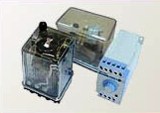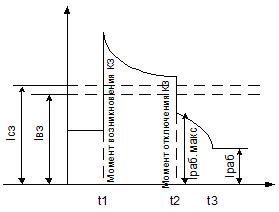Overcurrent protection
 When a short circuit occurs in an electrical system, in most cases the current rises to a value much higher than the maximum operating current. The protection responding to this increase is called current protection. Overcurrent protections are the simplest and cheapest. That is why they are widely used in networks up to 35 kV inclusive.
When a short circuit occurs in an electrical system, in most cases the current rises to a value much higher than the maximum operating current. The protection responding to this increase is called current protection. Overcurrent protections are the simplest and cheapest. That is why they are widely used in networks up to 35 kV inclusive.
Sets current on the power supply side of the line, protections are installed to turn off switches 1, 2, 3. In the event of a fault in one of the sections of the network, the fault current passes through all relays. If the current short-circuits with more protection current, these protections will take effect. However, according to the selectivity condition, only one overcurrent protection should operate and open the circuit breaker—the one closest to the fault location.
This protective action can be achieved in two ways. The first is based on the fact that the fault current decreases with distance from the fault location.
The protective operating current is chosen to be greater than the maximum value of the current in this section in case of failure of the next one, which is more distant from the power source.The second method is to create a delay in the protections response time the closer the protection is to the power source.
At time t1 there is a short circuit... At time t2 the overcurrent protection (MTZ) is triggered and turns off the switch. Motors shorted as a result of the voltage drop were delayed and their current increased when the voltage was restored. Therefore, the coefficient kz is introduced - the coefficient of self-starting of the engines. A reliability factor kn is also introduced to account for different types of errors— current transformers etc. After disconnecting the external maximum short-circuit current, the protection must return to its original state. The reverse current is given by the following expression:

The pickup and drop currents should be close. Enter the rate of return:

Taking into account the reset factor, the operating current is determined as follows:

For "ideal" relays, the return factor is 1. Realistically protective relay have a coefficient of restitution less than 1 due to friction in moving parts, etc. The higher the return factor, the lower the operating current can be selected at a given load, therefore, more sensitive maximum current protection.
The time delays of the protections are chosen in such a way that each subsequent protection to the power supply has a response time greater than the maximum time delay of the previous one by the magnitude of the selectivity step.
The degree of selectivity depends on the errors of the measuring protective devices and on the distribution of the operating time of the switches.
There are several types of overcurrent protection characteristics—independent and dependent. It is convenient to combine the dependent response characteristics with the protective characteristics of fuses and the heating characteristics of protected connections, for example electric motors. The most commonly used IEC dependent characteristics are:

where A, n — coefficients, k — current multiplicity k = Azrob/Icp.



